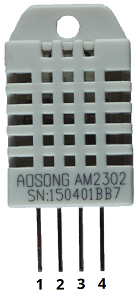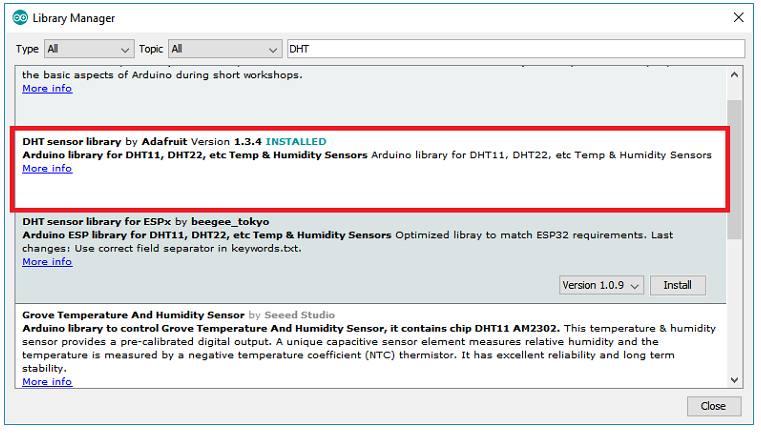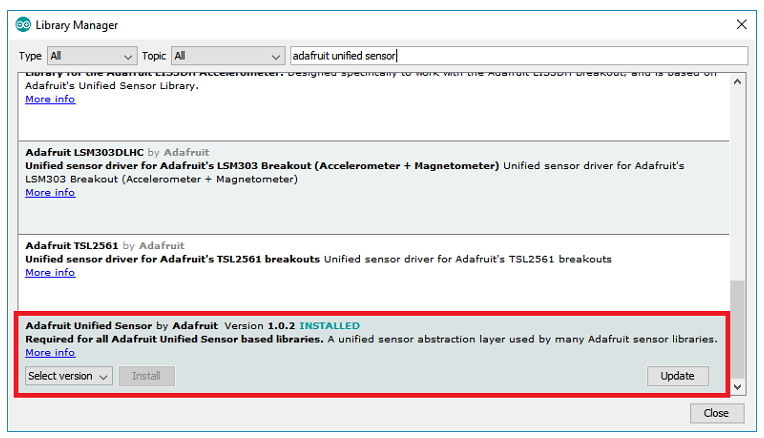DHT11 و DHT22 سنسور های اندازه گیری دما و رطوبت می باشند که خروجی آن ها به صورت کالیبره شده است . این سنسور ها به دلیل دقت بالا کاربرد فراوانی در اینترنت اشیا و به طور کلی در جمع آوری داده های دما و رطوبت محیطی دارند . در نوشته های قبلی آموزش راه اندازی این سنسور ها با آردوینو را شرح دادیم . به دلیل کاربرد فراوان ماژول های ESP32 در گره های ارتباطی IoT در این آموزش به راه اندازی این سنسور ها توسط ESP32 خواهیم پرداخت . یکی از مزیت های مهم سنسور های DHT قابلیت راه اندازی آن ها از طریق I2C و 1Wire است .
در تصویر زیر پایه های سنسور DHT22 نشان داده شده است :
پین های 1 و 4 به ترتیب تغذیه 3.3 ولت و GND می باشند . پین2 نیز خروجی ارتباط 1Wire است که باید با یک مقاومت 10 کیلو اهم آن را به پین تغذیه متصل کنید .
شماتیک اتصال DHT22 به ESP32 :
کد های آردوینو IDE
قبل از آپلود کد ها بر روی برد ESP32 کتابخانه های نشان داده شده در تصاویر زیر را نصب کنید :
#include "DHT.h"
#define DHTPIN 4 // Digital pin connected to the DHT sensor
// Feather HUZZAH ESP8266 note: use pins 3, 4, 5, 12, 13 or 14 --
// Pin 15 can work but DHT must be disconnected during program upload.
// Uncomment whatever type you're using!
//#define DHTTYPE DHT11 // DHT 11
#define DHTTYPE DHT22 // DHT 22 (AM2302), AM2321
//#define DHTTYPE DHT21 // DHT 21 (AM2301)
// Connect pin 1 (on the left) of the sensor to +5V
// NOTE: If using a board with 3.3V logic like an Arduino Due connect pin 1
// to 3.3V instead of 5V!
// Connect pin 2 of the sensor to whatever your DHTPIN is
// Connect pin 4 (on the right) of the sensor to GROUND
// Connect a 10K resistor from pin 2 (data) to pin 1 (power) of the sensor
// Initialize DHT sensor.
// Note that older versions of this library took an optional third parameter to
// tweak the timings for faster processors. This parameter is no longer needed
// as the current DHT reading algorithm adjusts itself to work on faster procs.
DHT dht(DHTPIN, DHTTYPE);
void setup() {
Serial.begin(9600);
Serial.println(F("DHTxx test!"));
dht.begin();
}
void loop() {
// Wait a few seconds between measurements.
delay(2000);
// Reading temperature or humidity takes about 250 milliseconds!
// Sensor readings may also be up to 2 seconds 'old' (its a very slow sensor)
float h = dht.readHumidity();
// Read temperature as Celsius (the default)
float t = dht.readTemperature();
// Read temperature as Fahrenheit (isFahrenheit = true)
float f = dht.readTemperature(true);
// Check if any reads failed and exit early (to try again).
if (isnan(h) || isnan(t) || isnan(f)) {
Serial.println(F("Failed to read from DHT sensor!"));
return;
}
// Compute heat index in Fahrenheit (the default)
float hif = dht.computeHeatIndex(f, h);
// Compute heat index in Celsius (isFahreheit = false)
float hic = dht.computeHeatIndex(t, h, false);
Serial.print(F("Humidity: "));
Serial.print(h);
Serial.print(F("% Temperature: "));
Serial.print(t);
Serial.print(F("°C "));
Serial.print(f);
Serial.print(F("°F Heat index: "));
Serial.print(hic);
Serial.print(F("°C "));
Serial.print(hif);
Serial.println(F("°F"));
}




